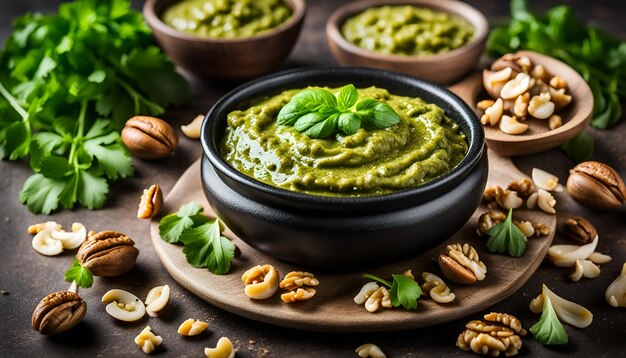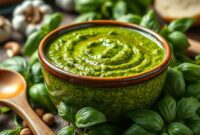Imagine the taste of summer captured in a vibrant green sauce, bursting with fresh basil, nutty Parmesan, and fragrant garlic. That’s exactly what you get with homemade pesto. Forget the store-bought versions, which often lack the intense flavor and freshness of the real deal. This pesto sauce recipe is incredibly easy to follow, even for beginner cooks, and the results are truly spectacular. Whether you’re tossing it with pasta, spreading it on sandwiches, or using it as a flavorful topping for grilled chicken or fish, this pesto will elevate any dish. Get ready to impress your friends and family with this authentic and delicious pesto sauce recipe!
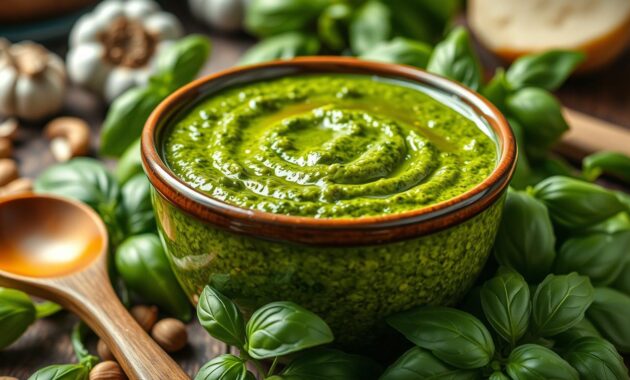
Let’s embark on a culinary journey to create the most exquisite pesto you’ve ever tasted. This recipe is not just about following steps; it’s about understanding the nuances of flavor, the texture, and the art of transforming simple ingredients into a symphony of taste. We will explore the secrets to achieving the perfect balance of basil, garlic, Parmesan, pine nuts, and olive oil, resulting in a pesto that will tantalize your taste buds and leave you craving more.
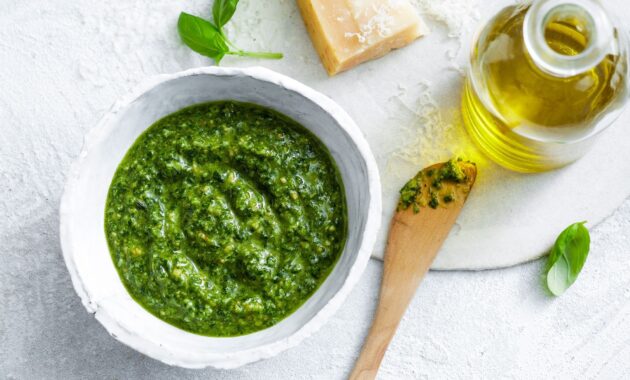
Pesto, originating from Genoa, Italy, is more than just a sauce; it’s a cultural icon, a celebration of fresh ingredients, and a testament to the power of simple cooking. The name ‘pesto’ comes from the Italian word ‘pestare,’ meaning ‘to crush’ or ‘to pound,’ referring to the traditional method of preparing the sauce with a mortar and pestle. While modern food processors offer a quicker alternative, understanding the traditional method helps appreciate the essence of pesto.

We’ll guide you through each step, from selecting the freshest basil leaves to achieving the ideal consistency. Whether you are a seasoned cook or a kitchen novice, this recipe will empower you to create a pesto that rivals the best restaurants. We’ll also share tips and tricks to customize the pesto to your liking, offering variations and substitutions that cater to different dietary needs and preferences.
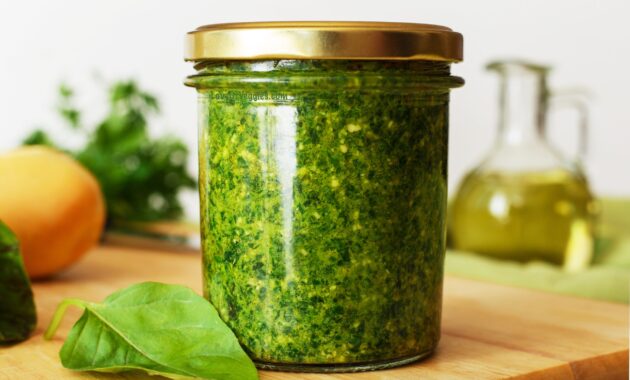
[Image Placeholder: A beautifully styled photo of freshly made pesto sauce, perhaps drizzled over pasta or served with crusty bread.]

Pesto Sauce Recipe Overview
Here’s a quick look at the essential details for making this fantastic pesto sauce:
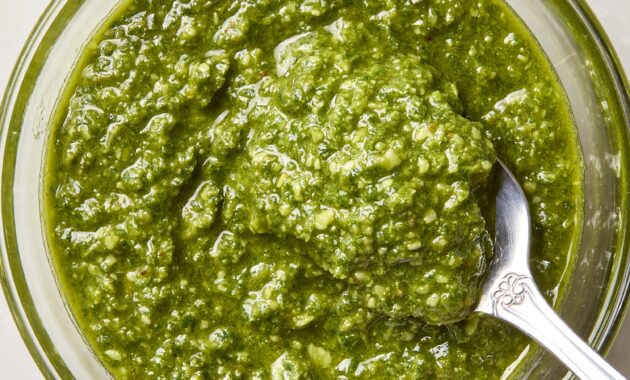
| Category | Value |
|---|---|
| Preparation Time | 15 minutes |
| Cook Time | 0 minutes (no cooking required!) |
| Servings | Approximately 1 cup |
| Difficulty | Easy |
Nutritional Information (per serving, approximately 2 tablespoons)
Please note that the following nutritional information is an estimate and can vary based on specific ingredients used.
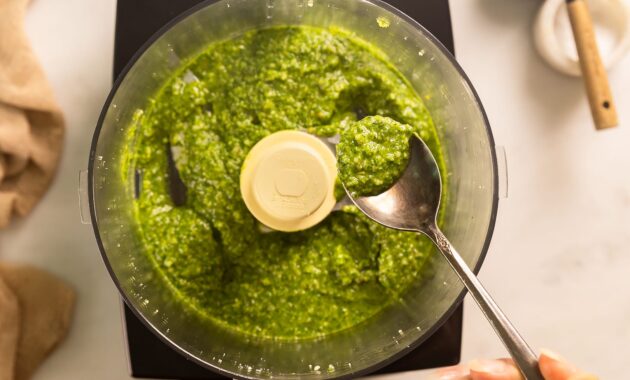
| Nutrient | Approximate Amount |
|---|---|
| Calories | 180-220 |
| Fat | 18-22g |
| Saturated Fat | 4-6g |
| Cholesterol | 10-15mg |
| Sodium | 150-200mg |
| Carbohydrates | 4-6g |
| Fiber | 1-2g |
| Sugar | 0-1g |
| Protein | 4-6g |
Remember that pesto is relatively high in fat due to the olive oil and nuts. Enjoy it in moderation as part of a balanced diet.
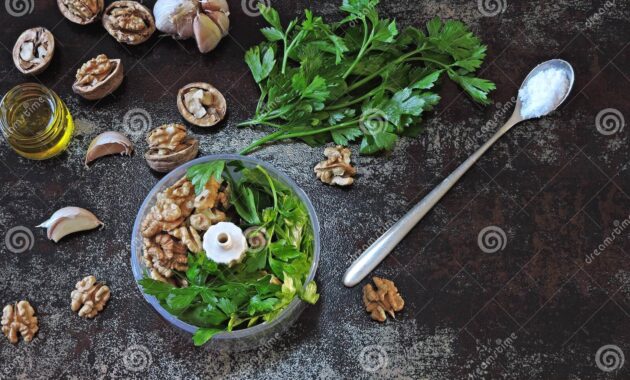
Ingredients for the Best Pesto Sauce Recipe
Gather these simple, yet essential ingredients for a truly authentic pesto experience:
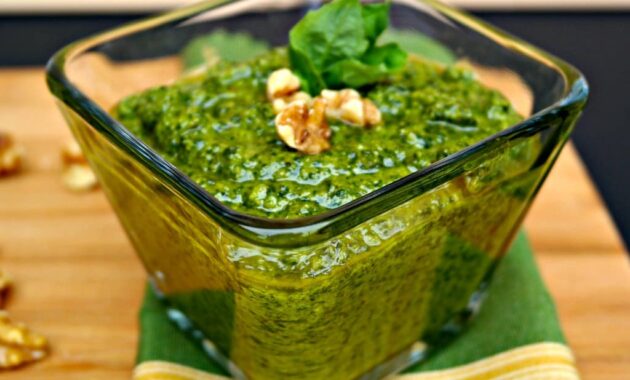
| Ingredient | Quantity | Notes |
|---|---|---|
| Fresh Basil Leaves | 2 cups, packed | Use fresh, vibrant green basil leaves. Avoid any wilted or bruised leaves. Genovese basil is the preferred variety. |
| Pine Nuts | 1/3 cup | Toasting the pine nuts lightly enhances their flavor. Watch them carefully as they burn easily. You can substitute walnuts or almonds if needed. |
| Garlic Cloves | 2-3 cloves, depending on size and preference | Use fresh garlic for the best flavor. Adjust the amount to your taste. |
| Parmesan Cheese | 1/2 cup, grated | Use freshly grated Parmesan cheese for the best flavor and texture. Parmigiano-Reggiano is the ideal choice. |
| Extra Virgin Olive Oil | 1/2 cup | Use a good quality extra virgin olive oil for the best flavor. |
| Salt | To taste | Start with a small amount and add more to taste. |
| Black Pepper | To taste (optional) | Freshly ground black pepper can add a subtle kick to the pesto. |
Cooking Instructions
Follow these step-by-step instructions to create a vibrant and flavorful pesto sauce:

- Prepare the Basil: Gently wash the basil leaves and pat them dry with a clean kitchen towel or paper towels. Removing excess moisture is crucial to prevent a watery pesto. Discard any thick stems. Only use the leaves.
- Toast the Pine Nuts (Optional): In a dry skillet over medium heat, toast the pine nuts for 2-3 minutes, or until lightly golden and fragrant. Be careful not to burn them, as they can turn bitter quickly. Remove from heat and let them cool slightly. Toasting the pine nuts enhances their nutty flavor, adding depth to the pesto.
- Combine Ingredients in a Food Processor: Place the basil leaves, toasted pine nuts (or walnuts/almonds), garlic cloves, and Parmesan cheese in the bowl of a food processor.
- Pulse Until Finely Chopped: Pulse the food processor several times until the ingredients are finely chopped and well combined. Avoid over-processing at this stage.
- Slowly Drizzle in Olive Oil: With the food processor running, slowly drizzle in the extra virgin olive oil in a steady stream. Continue processing until the mixture forms a smooth, emulsified sauce. The consistency should be thick but spreadable.
- Season with Salt and Pepper: Season the pesto with salt and pepper to taste. Start with a small pinch of salt and add more as needed, tasting as you go.
- Adjust Consistency (If Needed): If the pesto is too thick, add a little more olive oil, one tablespoon at a time, until you reach the desired consistency. If it’s too thin, add a little more Parmesan cheese.
- Taste and Adjust: Give the pesto a final taste and adjust the seasoning as needed. You may want to add a little more garlic, Parmesan cheese, or salt to suit your preference.
- Store Properly: Transfer the pesto to an airtight container. To prevent oxidation and browning, pour a thin layer of olive oil over the surface of the pesto before sealing the container. Store in the refrigerator for up to 5 days, or freeze for longer storage.
Serving Suggestions for Pesto Perfection
The possibilities are endless when it comes to using your freshly made pesto! Here are a few ideas to get you started:
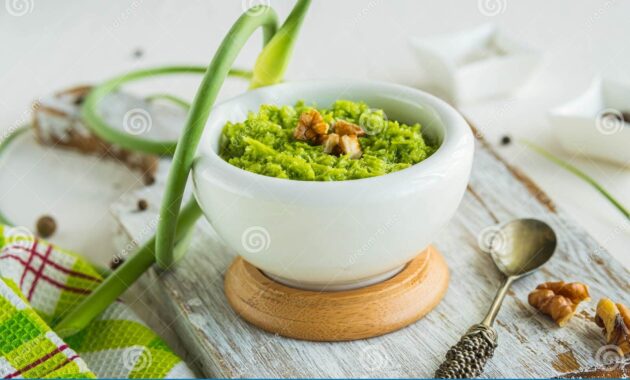
- Pasta: Toss pesto with your favorite pasta shape, such as spaghetti, linguine, or penne. Add some cherry tomatoes, grilled chicken, or shrimp for a complete meal.
- Sandwiches and Wraps: Spread pesto on sandwiches or wraps for a flavorful twist. It pairs well with roasted vegetables, grilled meats, and cheeses.
- Pizza: Use pesto as a base for homemade pizza, topping it with mozzarella cheese, sun-dried tomatoes, and olives.
- Grilled Meats and Vegetables: Brush pesto on grilled chicken, fish, or vegetables for added flavor.
- Dips and Appetizers: Serve pesto as a dip with crusty bread, crackers, or vegetable sticks.
- Soups: Swirl a spoonful of pesto into creamy soups for a burst of flavor.
- Eggs: Stir pesto into scrambled eggs or omelets for a delicious and flavorful breakfast.
Experiment and discover your own favorite ways to enjoy this versatile and flavorful pesto sauce!
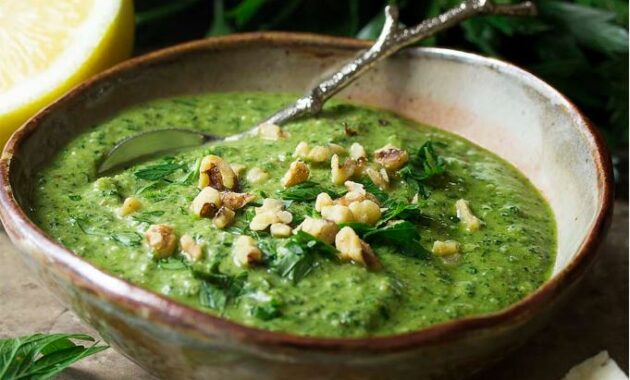
Tips and Tricks for the Best Pesto Sauce Recipe
Here are some additional tips and tricks to ensure your pesto is a masterpiece:

- Use Fresh, High-Quality Ingredients: The quality of your ingredients will directly impact the flavor of your pesto. Use the freshest basil, good quality olive oil, and freshly grated Parmesan cheese.
- Don’t Over-Process: Over-processing the pesto can result in a bitter taste. Pulse the food processor in short bursts and avoid running it continuously for too long.
- Control the Garlic: The amount of garlic you use is a matter of personal preference. Start with two cloves and add more to taste.
- Toast the Pine Nuts (or Substitute): Toasting the pine nuts enhances their flavor. If you don’t have pine nuts, you can substitute walnuts or almonds.
- Prevent Browning: To prevent the pesto from browning, pour a thin layer of olive oil over the surface before storing it in the refrigerator or freezer.
- Freeze Pesto in Ice Cube Trays: For easy portioning, freeze pesto in ice cube trays. Once frozen, transfer the pesto cubes to a freezer bag for longer storage.
- Add a Squeeze of Lemon Juice: A squeeze of lemon juice can brighten the flavor of the pesto and help prevent oxidation.
- Consider Adding a Pinch of Red Pepper Flakes: For a little heat, add a pinch of red pepper flakes to the pesto.
- Experiment with Different Herbs: While traditional pesto is made with basil, you can experiment with other herbs such as parsley, cilantro, or mint.
This pesto sauce recipe offers a canvas for creativity and culinary exploration. Feel free to adjust the ingredients and techniques to suit your taste and preferences. Whether you stick to the classic recipe or venture into new flavors, the most important thing is to enjoy the process and savor the delicious results.

Homemade pesto is so much better than store-bought! Making your own pesto sauce allows you to control the ingredients and customize the flavor to your liking. This recipe is quick, easy, and guaranteed to impress. With a simple blend of fresh basil, pine nuts, garlic, Parmesan cheese, and olive oil, you’ll have a vibrant and flavorful sauce that elevates any dish. Whether you’re a seasoned cook or just starting out, this pesto sauce recipe is a must-try. It’s the perfect way to capture the essence of summer in a jar and enjoy it year-round. The aroma alone is enough to transport you to the Italian countryside. Try this pesto sauce recipe today and experience the difference!
